| Trinidad & Tobago plays host to the "Great Show on Earth" known as carnival. Carnival has always been about social expression and the voice of society which is displayed on the streets of the country in an highly-spirited celebration of energy. Many people like to play traditional characters (mas) on the streets from the past which help to preserve the various social customs of an evolving culture, that provides a vital and essential link to the country's rich heritage. |
Baby Dolls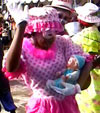 The baby doll character, which is now extinct, was played up to the 1930s. The masquerader portrays a gaily dressed doll, decked out in a frilled dress and bonnet. In her arms she carries a doll which symbolises an illegitimate baby. The masquerader portraying the baby doll, stops male passers-by and accuses them of being the baby's father.
The baby doll character, which is now extinct, was played up to the 1930s. The masquerader portrays a gaily dressed doll, decked out in a frilled dress and bonnet. In her arms she carries a doll which symbolises an illegitimate baby. The masquerader portraying the baby doll, stops male passers-by and accuses them of being the baby's father.
|
Bats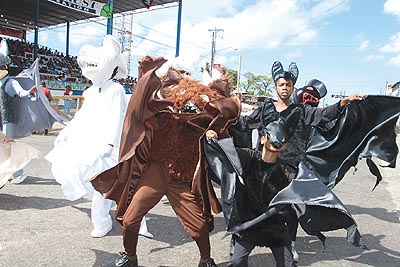 The bat costume is normally black or brown and fitted tightly over the masquerader's body. The headpiece covers the head entirely and is made from swansdown and papier mache face, teeth, nose and round eyes.. The mouth is used for vision and occasionally the mask is lifted to his forehead for a breath of air. Leather shoes with metal claws for toes are normally used. Ordinary shoes can also be adapted by the use of long socks, metal claws and a second sole. The wings with a wingspan from 12-15 feet are made from wire and bamboo or cane and covered with the same skin tight cloth worn on the body. Matching gloves complete the costume. There is a bat dance to go with the costume. In performance, the masquerader crawls, flaps, dances on his toes, and folds his wings in a series of choreographed movements, imitating the bat. Those who played bat mas long enough acquired the reputation of beginning to resemble the bat.
The bat costume is normally black or brown and fitted tightly over the masquerader's body. The headpiece covers the head entirely and is made from swansdown and papier mache face, teeth, nose and round eyes.. The mouth is used for vision and occasionally the mask is lifted to his forehead for a breath of air. Leather shoes with metal claws for toes are normally used. Ordinary shoes can also be adapted by the use of long socks, metal claws and a second sole. The wings with a wingspan from 12-15 feet are made from wire and bamboo or cane and covered with the same skin tight cloth worn on the body. Matching gloves complete the costume. There is a bat dance to go with the costume. In performance, the masquerader crawls, flaps, dances on his toes, and folds his wings in a series of choreographed movements, imitating the bat. Those who played bat mas long enough acquired the reputation of beginning to resemble the bat.
|
Bookman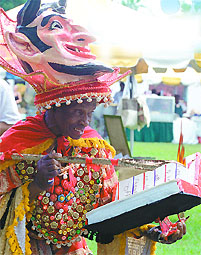 The Bookman, also referred to as the Gownman or Ruler, is a feature of devil mas portrayals. The other two groups of characters in the devil band are the imps and beasts. The bookman is the principal character in the devil band, and, in keeping with his status, his movement is waltz-like, with constant bowing. Musical accompaniment is provided by an orchestra of trumpet, saxophones, bass and drums playing conventional tunes.
The Bookman, also referred to as the Gownman or Ruler, is a feature of devil mas portrayals. The other two groups of characters in the devil band are the imps and beasts. The bookman is the principal character in the devil band, and, in keeping with his status, his movement is waltz-like, with constant bowing. Musical accompaniment is provided by an orchestra of trumpet, saxophones, bass and drums playing conventional tunes.
The bookman's costume consists of Tudor-style pants, or a richly embroidered gown made of velvet and satin, with a pleated or fluted bodice, and a flowing cape festooned with biblical scenes. On his head is an oversized head mask which contains small horns and carries a demonic expression. The face of this mask is supposed to mirror the face of the devil himself. The bookman carries a pen and a large book in which he write the names of prospective souls for the devil. |
Burrokeet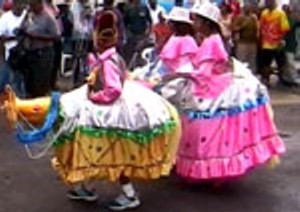 Burrokeet, derived from the Spanish word burroquito (little donkey). The burrokeet is constructed from bamboo so as to give the illusion of a dancer riding a small burro or donkey when he put his head through the hole in the donkey's neck and the body of the animal fitted around his hips and carries the reins in his hands.. The Burrokeet tradition existed both in East Indian Hindu culture and on the South American mainland.
Burrokeet, derived from the Spanish word burroquito (little donkey). The burrokeet is constructed from bamboo so as to give the illusion of a dancer riding a small burro or donkey when he put his head through the hole in the donkey's neck and the body of the animal fitted around his hips and carries the reins in his hands.. The Burrokeet tradition existed both in East Indian Hindu culture and on the South American mainland.
The costume is comprised of a donkey's head made from coloured paper on a wooden or bamboo frame, while the body was covered with a long satin skirt with a sisal tail, sometimes decorated with flowers. The bit and bridle are made of coloured cord. The "rider" wore a satin shirt and a large matador's hat or straw hat and dances in a way that mimmicks the antics of a donkey and also bows to the accompaniment of guitars, cuatros and shac-shacs. He performs a dance called Burriquite, which originated in Venezuela. |
Clowns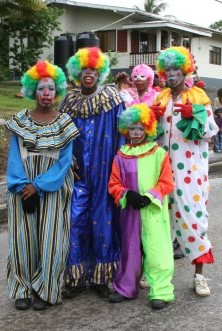 Traditionally clowns were considered "fools" and carried all kind of antics to entertain and interest a crowd. These clowns were dressed in baggy clothing with big red noses, wild hair, big shoes and often, white faces.
Traditionally clowns were considered "fools" and carried all kind of antics to entertain and interest a crowd. These clowns were dressed in baggy clothing with big red noses, wild hair, big shoes and often, white faces.
Closely following the traditional clowns would be your Fancy Clowns who are connected with carnival with their own dances and usually a major player in a Fancy Sailor band. These clowns show the beauty of the design of many of the original or old time masqueraders. |
Cow Bands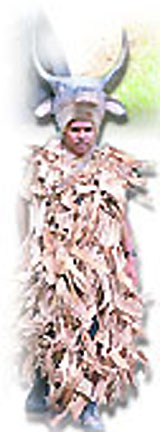 The Cow Band, which dates back to the days of the Canboulay was traditionally played by abattoir employees. On Carnival Monday it consisted of a small group of men dressed in gowns of sacking made from rice bags. These gowns were completely covered with dried plantain leaves. Each masquerader wore a homemade papier-mâché mask representing the head of a cow mounted by a pair of cow horns where they would charge the bullfighter.
The Cow Band, which dates back to the days of the Canboulay was traditionally played by abattoir employees. On Carnival Monday it consisted of a small group of men dressed in gowns of sacking made from rice bags. These gowns were completely covered with dried plantain leaves. Each masquerader wore a homemade papier-mâché mask representing the head of a cow mounted by a pair of cow horns where they would charge the bullfighter.
In later years, on Carnival Tuesday, the Cow Band came out in brightly coloured costumes, with picadors and a matador who would challenge the cows. The cow character's costume consisted of tight-fitting breeches of yellow velvet or satin, with gold braid and spangles along the sides and around the bottom at the knees, a tight-fitting maroon satin long-sleeved blouse completely covered with a sutach decoration of gold braid, gloves, cream stockings and alpagatas (footwear). A cap on the head with mounted pair of cow horns. A short section of the hairy part of the cow's tail was attached to the seat of the breeches. An imported wire gauze mask was used on Tuesday which replaced the cow mask played on the carnival Monday. Members of the band would frolic and move through the crowds behaving like real cows. The bullfighter sported a black matador's or admiral's hat. The 'bull', with wore tail and horns held in place by a head tie would attack bullfighter and bystanders alike. Male singers and the musicians wore yellow breeches, maroon shirts with billowing sleeves tight at the wrist, a sash around the waist and red beret. The women wore yellow skirts, red or maroon bodices, and headties. All wore masks of the wire gauze type, those of the women being decorated with gold braid along the forehead and at the sides, with gaudy earrings dangling from them. Music was provided by such string instruments as the mandolin, teeplay, bandol, banjo, cuatro, guitar, violin and chac-chacs (maracas). |
Dame Lorraine or Dame Lorine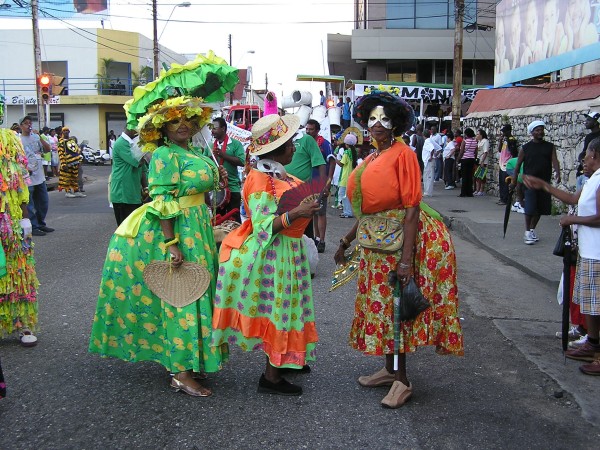 The Dame Lorraine or Dame Lorine was a mas character played by the 18th and early 19th century French planters, who would dress up in elegant costumes of the French aristocracy and parade in groups at private homes/yards and Carnival Sunday night.
The Dame Lorraine or Dame Lorine was a mas character played by the 18th and early 19th century French planters, who would dress up in elegant costumes of the French aristocracy and parade in groups at private homes/yards and Carnival Sunday night.
They performed two sophisticated dances of the period. The first part featured a parade of people dressed in costumes of the 18th century French aristocrats. A haughty butler introduced arriving couples, after which a stately dance was performed while a slave gaped through a window at the proceedings. In the second part the butler was transformed into a schoolmaster calling the pupil's roll. The pupils dressed in ragged imitations of the aristocratic costumes displayed in first performance, had exaggerated physical characteristics suggested by their names : Misie Gwo Koko, Misie Gwo Lolo, Ma Grand Tete. The liberated slaves recreated these costumes, complete with elaborate fans and hats in their own fashion, using materials that were readily available, such as assorted rags and imitative jewellery-type items. Male and female players alike were masked and danced to a tune played by cuatro and bandol groups. The tune which became associated with the Dame Lorraines still exists, and is played whenever they appear in groups at cultural events. The major Dame Lorraine performers through the years however, were descendants of the French planters and persons of some respectability, who hid behind masks, mainly of the fine wire mesh variety, and found their way into the downtown Old Yards, where they paraded and danced for all and sundry. |
Dragon Inspired from the Jab Jab or Devil Mas, the Dragon (sometimes refer as King Beast) mas is one rooted in the understanding of good and evil and all its elements. The Dragon is designed as a dragon, an overall costume of scales, a dragonhead with a movable tongue and a long scaled tail. Chains are tied around the beasts that are also held by Imps, in order to restrain it.
Inspired from the Jab Jab or Devil Mas, the Dragon (sometimes refer as King Beast) mas is one rooted in the understanding of good and evil and all its elements. The Dragon is designed as a dragon, an overall costume of scales, a dragonhead with a movable tongue and a long scaled tail. Chains are tied around the beasts that are also held by Imps, in order to restrain it.
The Dragon is the fire-beast from hell, coming to earth as a bringer of destruction. Dancing through the streets, the aim of the “Dragon Dance” is to captivate and frighten its audience. However, when the Dragon is unfortunate enough to come across a pool of water in the road, then the real dance begins. Water or holy water being of heaven leaves the Dragon in a state of frustration, he cannot ‘cross the water’ to continue on his journey. Instead his Imps, usually led by the King Imp, taunt him and finally the Dragon must dance in submission and then with much effort leap over the water in order to continue. |
Fancy Indians Among the most spectacular mas costumes, Fancy Indians are based on the indigenous peoples of North America. The wearer decides how expensive or expansive he wants this costume to be.
Among the most spectacular mas costumes, Fancy Indians are based on the indigenous peoples of North America. The wearer decides how expensive or expansive he wants this costume to be.
The headpiece in its simplest form, has grown over the years in splendour and size is worn with feathers sticking up, and more feathers making tails down the back. More elaborate headpieces are built over bamboo or wire frames supported by the masquerader's body. A masquerader's 'wigwam' is worked with ostrich plumes, mirrors, beads, feathers, papier mache masks, totem poles, canoes and ribbons. Bands of Indians can comprise a warrior chief and his family, a group of chiefs, or a group of warriors. The Fancy Indian is the most popular variety of Indian mas. A feature of this mas is the language or languages they speak, in a call and response pattern, possibly adapted from the Black Indians of the New Orleans Mardi Gras and their characteristic movements. Other kinds of Indians that are disappearing are generally known as Wild Indians. These comprise Red Indians (Warahoons) and Blue Indians, which have links with the indigeneous peoples of Venezuela. There are also Black Indians or African Indians. |
Jab Jab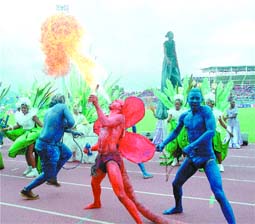 The name of this mas is derived from the French patois for 'Diable Diable" meaning a pretty devil mas resembling a mediaeval jester's costume. The costume consists of a Kandal or satin knickers, and satin shirt which are divided into panels of alternating colours with points of cloth at the waist, from which bells hang. On the chest, there is a shaped cloth panel which is decorated with swansdown, rhinestones and mirrors. Stockings and alpagatas are worn on the feet, while the headress consists of a hood with stuffed cloth horns. The Jab Jab has a thick whip of plaited hemp which he swings and cracks threateningly. These whips can reduce the costumes of other Jab Jabs to threads.
The name of this mas is derived from the French patois for 'Diable Diable" meaning a pretty devil mas resembling a mediaeval jester's costume. The costume consists of a Kandal or satin knickers, and satin shirt which are divided into panels of alternating colours with points of cloth at the waist, from which bells hang. On the chest, there is a shaped cloth panel which is decorated with swansdown, rhinestones and mirrors. Stockings and alpagatas are worn on the feet, while the headress consists of a hood with stuffed cloth horns. The Jab Jab has a thick whip of plaited hemp which he swings and cracks threateningly. These whips can reduce the costumes of other Jab Jabs to threads.
|
Jab Molassie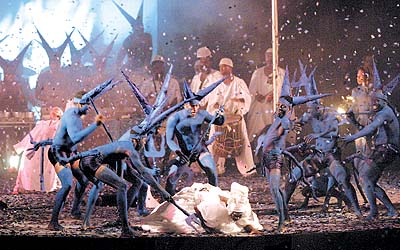 Jab is the French patois for 'Diable' (Devil), and Molassie is the French patois for Mélasse (Molasses) is one of several types of devil mas. The simple costume consists of short pants or pants cut off at the knee, with a wire tail, mask and horns and a pitchfork. The jab malassie would carry chains, and wear locks and keys around his waist, and carry a pitch fork. The whole body is smeared with grease or mud, red, green or blue paint. The jab molassie "wines" or gyrates to a rhythmic beat that is played on tins or pans by his imps. While some of his imps supply the music, others hold his chain, seemingly restraining him as he pulls against them in his wild dance.
Jab is the French patois for 'Diable' (Devil), and Molassie is the French patois for Mélasse (Molasses) is one of several types of devil mas. The simple costume consists of short pants or pants cut off at the knee, with a wire tail, mask and horns and a pitchfork. The jab malassie would carry chains, and wear locks and keys around his waist, and carry a pitch fork. The whole body is smeared with grease or mud, red, green or blue paint. The jab molassie "wines" or gyrates to a rhythmic beat that is played on tins or pans by his imps. While some of his imps supply the music, others hold his chain, seemingly restraining him as he pulls against them in his wild dance.
|
Midnight Robber The Midnight Robber is one of the most beloved colourful traditional carnival characters. Midnight Robber, is immediately identifiable by his extravagant costumes and distinctive speech, called “Robber Talk”
The Midnight Robber is one of the most beloved colourful traditional carnival characters. Midnight Robber, is immediately identifiable by his extravagant costumes and distinctive speech, called “Robber Talk”
The "Robber Talk" is derived from the tradition of the African Griot or storyteller, and the speech patterns and vocabulary are imitative of his former master and is characterised by its boastful, mocking style was derived from a variety of sources: the Bible, literary texts and school readers and speaks of the Robber's invincible ancestry as well as his terrifying exploits. Originally inspired by cowboy costumes, the Robber sports an oversize hat with fringed brim, the crown assuming different shapes (graveyard, coffin, The Red House); a flowing cape decorated with symbols of death and destruction; black satin shirt and pantaloons generally in black and shoes or boots resembling an animal with moving eyes. He summons and dismisses his audience with the blow of his whistle while threatening them with a gun, sword or dagger and a wooden money box in the shape of a coffin. |
Minstrels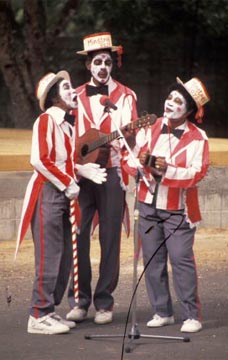 Black and white minstrels are based on the American minstrel shows popular around the turn of the century. The faces are painted white, while the costume consists of a scissors tail coat, striped trousers, tall straw hat and gloves. They accompany themselves on the guitar and the rattling bones played between the hands. They may sometimes have a dance routine.
Black and white minstrels are based on the American minstrel shows popular around the turn of the century. The faces are painted white, while the costume consists of a scissors tail coat, striped trousers, tall straw hat and gloves. They accompany themselves on the guitar and the rattling bones played between the hands. They may sometimes have a dance routine.
|
Moko Jumbie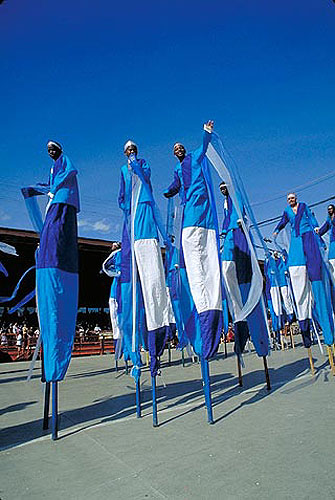 The stilt dancer known throughout the Caribbean, is a traditional folk character that was originally brought from West Africa. The word "Moko" is derived from the name of a West African God and "jumbie" or "ghost" was added by liberated slaves after Emancipation. It was believed that the height of the stilts was associated with the ability to foresee evil faster than ordinary men. The Moko Jumbie was felt to be a protector of the village.
The stilt dancer known throughout the Caribbean, is a traditional folk character that was originally brought from West Africa. The word "Moko" is derived from the name of a West African God and "jumbie" or "ghost" was added by liberated slaves after Emancipation. It was believed that the height of the stilts was associated with the ability to foresee evil faster than ordinary men. The Moko Jumbie was felt to be a protector of the village.
The stilt walker plays on stilts 10 to 15 feet high (often brightly painted in stripes). Moko wore long full skirts or pants, a brightly coloured satin or velvet jacket and an elaborate admiral's hat topped by plumes. The Moko Jumbie (sometimes accompanied by a dwarf in similar costume) would dance through the streets all day, collecting money from spectators gathered at second floor windows or on balconies. He danced a jig to the accompaniment of drum, triangle and flute or to the music of passing bands. |
Negue Jadin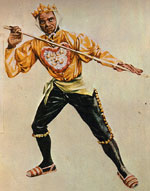 This character, which is now extinct, goes back to the pre-emancipation era. During that period, Carnival was observed by the upper classes mainly. While the slaves and free coloureds were not forbidden from celebrating carnival, they were compelled to stay within their own stratum of society and not presume to rub shoulders with the aristocracy. The planter class on the other hand, often imitated the dress and customs of their slaves during the carnival celebrations. One of their favourite disguises was that of the Negue Jadin or field slave.
This character, which is now extinct, goes back to the pre-emancipation era. During that period, Carnival was observed by the upper classes mainly. While the slaves and free coloureds were not forbidden from celebrating carnival, they were compelled to stay within their own stratum of society and not presume to rub shoulders with the aristocracy. The planter class on the other hand, often imitated the dress and customs of their slaves during the carnival celebrations. One of their favourite disguises was that of the Negue Jadin or field slave.
This costume consists of a tight-fitting satin or khaki breeches reaching to just above the knee where willows are hung, and a bright, plain coloured shirt with a "fol" or heart-shaped panel of contrasting colour sewn on the chest and bordered with swansdown. The 'fol' is decorated with tiny mirrors and rhinestones. As with all carnival costumes during this period, the masquerader covered his face with a mask. After emancipation, the former slaves adopted the Negue Jadin character in their carnival celebrations, but as a satirical portrayal of the planter trying to imitate them. |
Pierrot Grenade The Pierrot Grenade is a descendant of the Pierrot known for his elegant costume and fierce fighting prowess with a whip or bull pistle, and was followed by a band of female supporters who fought on his behalf against other Pierrot groups..
The Pierrot Grenade is a descendant of the Pierrot known for his elegant costume and fierce fighting prowess with a whip or bull pistle, and was followed by a band of female supporters who fought on his behalf against other Pierrot groups..
Pierrot Grenade was a finely dressed masquerader and deeply supreme scholar/ jester proud of his ability to spell any word in his own fashion and quoting Shakespearean characters as Julius Caesar, Mark Anthony and Othello at length. Pierrot Grenade, is a satire on the richer and more respectable Pierrot. The Pierrot Grenade gown consists of crocus bag (burlap), on which strips of coloured cloth, small tins containing pebbles, and small boxes that rattle, are attached. He may wear a hat or a coloured head tie on his head, and his face is covered with a mask. The mask provides anonymity for someone who delights in making barbed comments on "respectable" members of the community. This Peirrot is dressed in a satin gown covered with bells hung, with a velvet heart shaped breasted piece bordered in swansdown decorated with sequins and mirrors. Under his velvet beret he wore an iron pot to protect him from blows of opposing Pierrots' short steel or lead lined whips. A long train of strips embroidered with gold braids, stockinged feet in light shoes decorated with swansdown and bells completed his costume. The Pierrot was eventually driven from the streets after numerous arrests and goal sentences for fighting. Pierrot Grenade (supposedly from neighbouring Grenada) inherited his predecessor's love of oratory (speaking). |
Sailor Mas This character was introduced in the 1880s when British, French and American naval ships came to Trinidad. It is one of the more popular costumes, being lightweight and inexpensive. There are several variations on the sailor mas including Free French Sailor, King Sailor, and Fancy Sailor to name a few.
This character was introduced in the 1880s when British, French and American naval ships came to Trinidad. It is one of the more popular costumes, being lightweight and inexpensive. There are several variations on the sailor mas including Free French Sailor, King Sailor, and Fancy Sailor to name a few.
The costume of the Free French sailor consists of a black beret with the name of the ship on the rim of the beret, a tight-fitting short sleeve bow neck jersey with horizontal blue and white stripes, long, bell-bottomed black melton pants, and black shoes. The King Sailor's costume consists of a white drill or corduroy pants and shirt with a sailor collar. There are epaulettes on each shoulder, a red sash across the chest, a crown on the masquerader's head, cords, medals and war ribbons on the left side of the chest and a walking stick in his hand. The Fancy Sailor was an off-shoot of the King Sailor. The fancy sailor costume consists of papier-mâché headpieces, decorated and painted to look like bird, animals or plants. The sailor outfit is decorated with ribbons, medals, braiding, swansdown and other embellishments to match the headpieces. There are several dances to go along with the sailor mas portrayal, such as the Bote, Crab, Marrico, Pachanga, Rock de Boat, Skip Jack and the Camel Walk. |
| Information and images are courtesy of either NALIS or Triniview.com |
This site uses frames, if you do not see frames (menu on the left) click here.
Page maintained by www.tntisland.com, Copyright © 1996-2025 Last Revised: 06/01/2025.